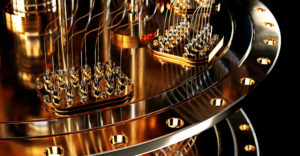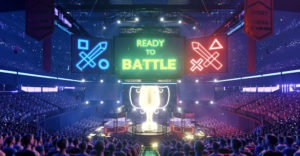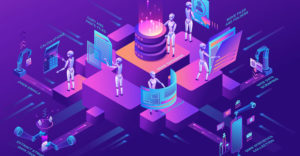
Our world has gone digital, so it makes sense that the worlds created by artists are going digital as well. A new generation of artists is blending creativity, art and technology in innovative and unpredictable ways — a process of testing limits and pushing boundaries that artists have always done.
“For me, art has always been about making technical experiments, and my art is the result of that process,” kinetic light sculptor and scientific artist Paul Friedlander told TechNewsWorld. “The traditional idea of art being about expressing inner feelings I am not consciously involved with at all, yet the process of fusing technical inquiry with art does produce powerfully emotional works.”
For artists like Friedlander, new digital technologies are the equivalent of what new blends of oil paints or new printing processes might have been to earlier artists.
Since he began creating art, the intersection of creativity and technology has fascinated Friedlander. One of his first light sculptures, “Dark Matter,” was a luminous, interactive waveform more than 20 feet tall that responded to hand gestures. “Dark Matter” was exhibited in New York in 1998, and since then, Friedlander’s light sculptures have become ever more advanced, using software that he himself has created.
“All my sculptures use sophisticated computer control,” explained Friedlander. “Along with interactivity, I can create richer content using algorithms to generate, transform and mold images that I project into my light sculptures.”
Multidimensional Possibilities
One benefit of digital technologies is that they allow for the creation of multidimensional — 3D and 4D — worlds. Animators, gamers, and even architects are making use of this capability to re-envision what art and design can do.
“I still like the traditional methods of doing artwork, but digital methods streamline my work,” graphic designer, animator, and filmmaker Jonathan Vinazza told TechNewsWorld.
Vinazza regularly uses 3D animation programs like Autodesk’s Maya and 3ds Max for his animation, but he emphasizes that though he’s creating multidimensional worlds with digital software, he’s still an artist trying to capture reality.
“You can make things look pretty realistic,” explained Vinazza. “But just like any art, it takes time to make a perfect image.”
Architects, too, are able to envision their designs differently via digital technologies.
“Unlike sculpture, architecture is a 4-dimensional debate and can’t be just valued by its 3D visualization,” architect and designer Kiumars Roshanzamir explained to TechNewsWorld. “Music can’t be heard if the time stops. The same goes to architecture if time is ignored.”
Roshanzamir uses 3D animation programs such as 3ds Max and Maxon’s Cinema 4D to capture this sense of time, space and movement in his architectural designs.
“Software technologies are just tools similar to the ways we used to bring the ideas through the ink of a pen onto the paper,” explained Roshanzamir. “The new technology is no longer a choice but a part of working process.”
Augmenting Reality
Augmented reality — which places images in locations viewable via smartphone apps such as Layar — is quickly becoming another major medium for digital artists, who are envisioning all kinds of possibilities for site-specific, socially networked, readily available art.
Brooklyn-based artist Mark Skwarek, for instance, is shaping his career out of technology that makes location-specific art viewable through smartphones and other mobile devices.
Skwarek, who teaches part-time at NYU, started out as a painter, but he knew he eventually wanted to get into digital art.
“I always sort of knew that I was going to videogame-type art,” he explained to TechNewsWorld. “I kept waiting until the technology was there to do the art I wanted to do.”
“You’re looking at the birth of a new form of art,” said Skwarek. “It really enables the artist to do things that could never be done before.”
Some of his recent projects include the “Sea of Tweets,” a collaborative project that lets people add the hashtag #seaoftweets to a tweet wishing goodwill to the victims of Japan’s tsunami and nuclear disaster. Each tweet is then turned into a virtual paper crane that appears when one points a Layar-enabled mobile device at Mount Fuji.
In another Twitter-based project, “Liberty to Libya,” an augmented reality dove is circling Tripoli, Libya with a scroll of tweets directed at the Libyan government.
Skwarek’s AR projects don’t always add something to the world, however; sometimes they take things away. In “erasAR,” for instance, Skwarek erased the Statue of Liberty and other symbols of freedom and democracy.
“A lot of people were trying to add things to reality,” said Skwarek. “What I was doing with erasAR was to erase things. I was trying to erase peoples’ hopes and dreams.”
Many of Skwarek’s AR pieces have a political bent, which is no accident.
“It’s the ultimate medium for political work,” said Skwarek of AR. “This is a way to make a statement, but no one is hurt and no one’s property is destroyed.”
Primitive and Crazy-Making
Skwarek is a founding member of the Manifest.AR, which is a community of artists exploring this new medium.
“This is a new kind of art,” said Skwarek. “Artists are pushing the technology in all kinds of directions. They’re starting to figure out different ways that it can be used.”
Since the technology is still emerging, AR still has kinks to work out. Like when Layar installed an update, disrupting one of Skwarek’s shows in progress and rendering it invisible for a period of time. The interface with smartphones and other devices is somewhat awkward, and GPS technology does not allow civilians the pinpoint accuracy that artists would like.
“It’s still sort of primitive,” said Skwarek of AR. “This technology is a bit cumbersome. It frustrates viewers.”
Skwarek envisions a future, though, when there might be AR-ready glasses that provide a more seamless glimpse of the art, or even perhaps nanobots that project images directly on the retina.
“There’s a lot of scary stuff that could be done with that,” said Skwarek. “You could drive someone crazy.”






















































Good article!